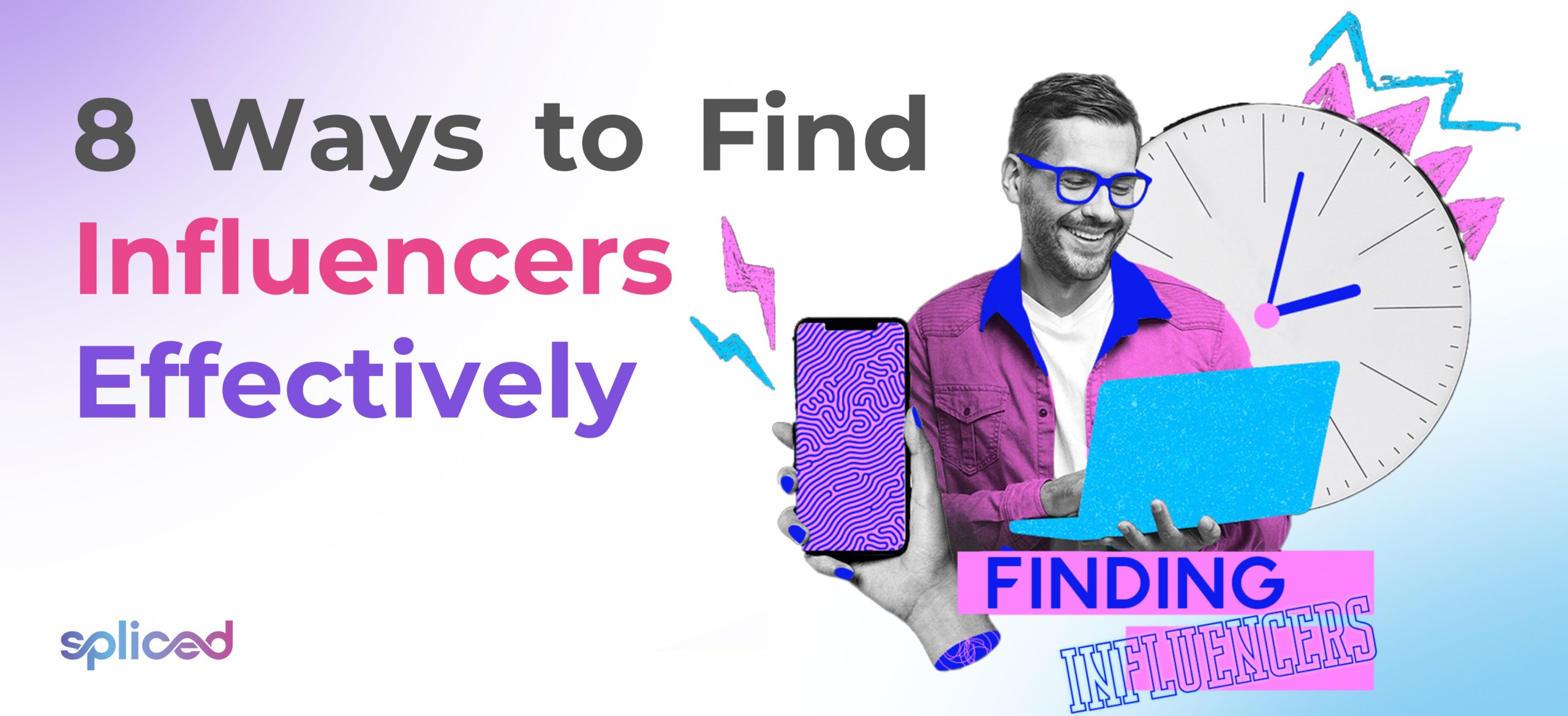Finding influencers effectively impacts the brand’s reach, credibility, and engagement with the target audience. Harnessing the power of influencers has become a cornerstone of effective marketing strategies. Find influencers who share the brand’s niche and values to promote the products or services, make more people aware of the brand, or get more people to buy from the brand. There are eight ways to find influencers effectively. The 3 important ways are analyzing the website’s analytics, connecting with influencers on LinkedIn, and googling influencers or bloggers in the brand’s industry. These ways help brands find the right influencers to boost the brand’s online profile, no matter how experienced the brand is as a marketer or how new the brand is to influencer marketing.
Listed below are the three important ways.
- Analyze Your Website’s Analytics: Analyzing website analytics is the process of examining data related to a website’s performance and user interactions, done using tools like Google Analytics. Analytics tools help track metrics such as visitors, bounce rates, and referral sources, providing valuable insights into the online audience.
- Connect with Influencers on LinkedIn: Connect with influential people on LinkedIn. A smart way to find and talk to important people in the field or area is to connect with leaders on LinkedIn. There are a lot of thought leaders, experts, and powerful people in the field on LinkedIn. LinkedIn is a site for professionals to connect with each other.
- Google Influencers or Bloggers in Your Industry: Search influential people or writers in the field on Google. Use search engines to find important people in the area when “Google” influencers or bloggers in the industry. Use related keywords to find influencers on blogs, social media profiles, and websites, among other places.
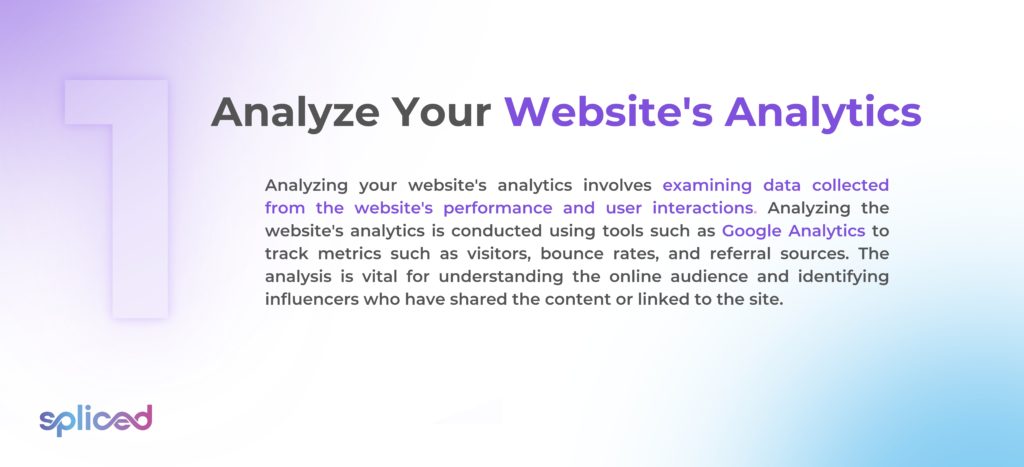
1. Analyze Your Website’s Analytics
Analyzing your website’s analytics involves examining data collected from the website’s performance and user interactions. Analyzing the website’s analytics is conducted using tools such as Google Analytics to track metrics such as visitors, bounce rates, and referral sources. The analysis is vital for understanding the online audience and identifying influencers who have shared the content or linked to the site.
The benefits of using website analytics for influencer marketing include data-driven insights, targeted outreach to interested influencers, and the ability to measure campaign success. However, analyzing the website’s analytics requires a learning curve, does not offer detailed influencer information, and is time-consuming. For instance, analytics reveal influencers who have driven traffic to the site through Instagram if an e-commerce site specializing in fitness gear, enables someone to approach them for collaborations to boost the brand’s visibility in the fitness community.
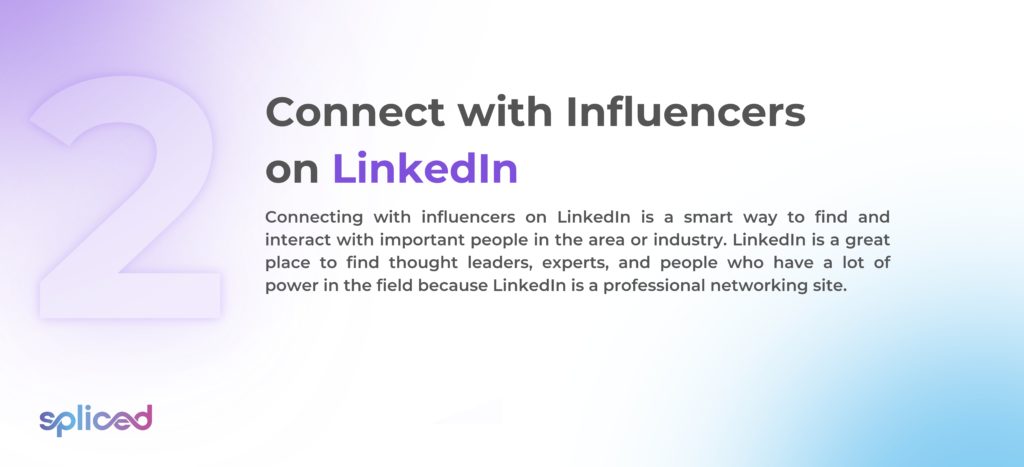
2. Connect with Influencers on LinkedIn
Connect with influencers on LinkedIn. Connecting with influencers on LinkedIn is a smart way to find and interact with important people in the area or industry. LinkedIn is a great place to find thought leaders, experts, and people who have a lot of power in the field because LinkedIn is a professional networking site.
Make a LinkedIn profile, search for influencers, and connect with them to use the approach. Interact with their content, join groups, and start conversations or work together with other people after connecting with professionals. Building relationships with leaders who give useful advice, act as a mentor, or endorse the brand is what the method is all about. ‘
Pros of connecting with influencers on LinkedIn include direct access to important professionals and the chance to network naturally. Cons include a smaller reach if influencers are picky about whom they connect with. For example, an individual meets with a well-known marketing expert on LinkedIn, which leads to chances to work together or share marketing knowledge.
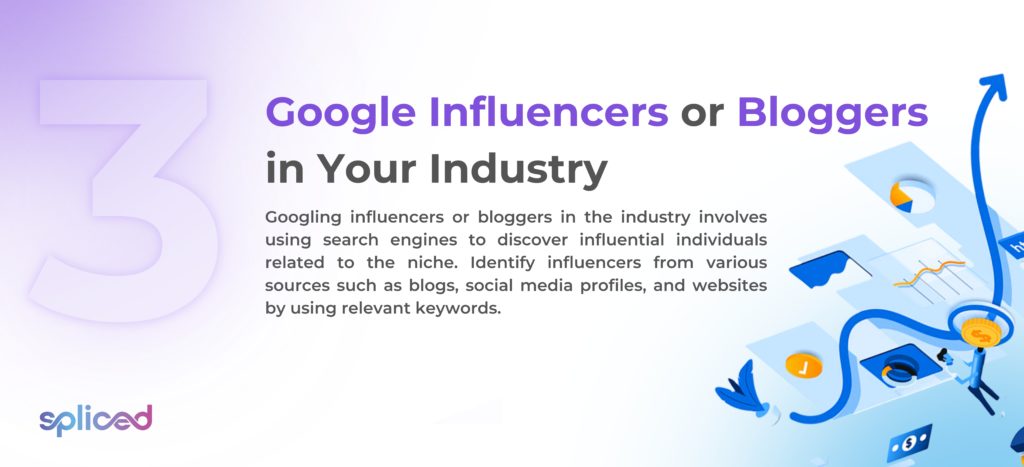
3. Google Influencers or Bloggers in Your Industry
Google influencers or bloggers in your industry. Googling influencers or bloggers in the industry involves using search engines to discover influential individuals related to the niche. Identify influencers from various sources such as blogs, social media profiles, and websites by using relevant keywords.
The method provides accessibility and a wide range of influencers, but requires time for research and evaluation. For example, a Google search for “travel influencers” leads to travel bloggers and content creators, allowing them to assess their suitability for collaborations within the travel industry if someone operates a travel agency.
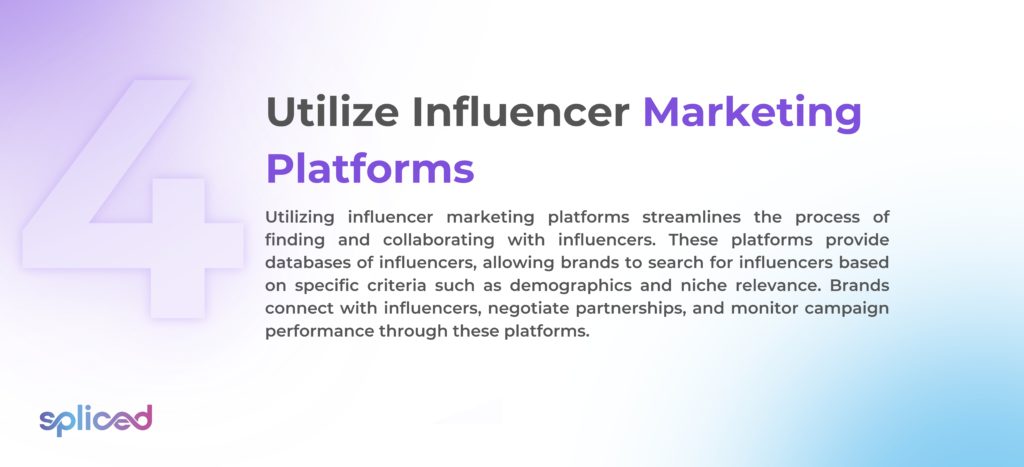
4. Utilize Influencer Marketing Platforms
Utilize Influencer Marketing Platforms such as Spliced. Utilizing influencer marketing platforms streamlines the process of finding and collaborating with influencers. These platforms provide databases of influencers, allowing brands to search for influencers based on specific criteria such as demographics and niche relevance. Brands connect with influencers, negotiate partnerships, and monitor campaign performance through these platforms.
The benefits include curated lists of influencers and campaign management tools, but there are platform fees and competition for popular influencers. For example, a fashion brand seeking beauty influencers on Instagram uses such a platform to find and partner with suitable influencers efficiently.
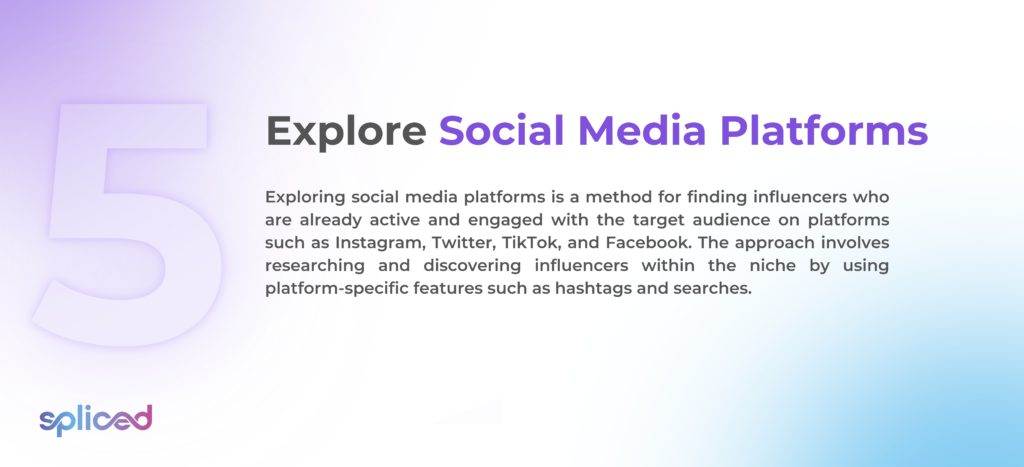
5. Explore Social Media Platforms
Explore Social Media Platforms. Exploring social media platforms is a method for finding influencers who are already active and engaged with the target audience on platforms such as Instagram, Twitter, TikTok, and Facebook. The approach involves researching and discovering influencers within the niche by using platform-specific features such as hashtags and searches.
Platform-specific features allow identifying individuals who have established a presence and a dedicated following in the industry. The pros include finding aligned influencers and assessing their authenticity, but it requires time and effort to evaluate potential collaborators. For example, searching for fitness-related hashtags on Instagram helps identify potential fitness influencers for marketing campaigns in the fitness industry.

6. Discover Video Content Creators on YouTube
Discover video content creators on YouTube, Discovering video content creators on YouTube is a method to identify influencers who specialize in creating video content. YouTube hosts a vast community of content creators spanning various niches. Search and explore YouTube to find creators relevant to the industry or interests to use the method.
The advantages include access to influential video content creators on YouTube, engaging visual content, and the opportunity to connect with audiences who prefer video. Vet influencers to ensure their content aligns with the brand. For instance, find tech enthusiasts on YouTube for product reviews and collaborations, expanding the reach within the tech community for a tech company.
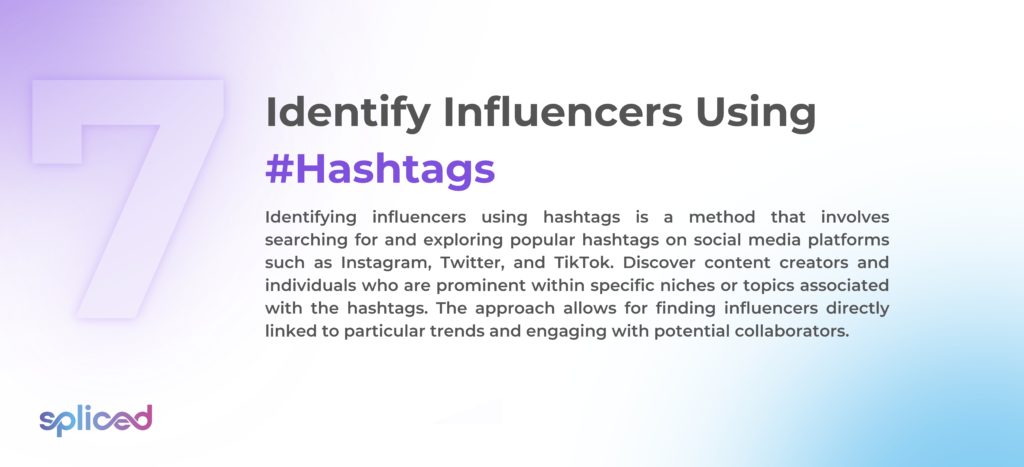
7. Identify Influencers Using Hashtags
Identify influencers using Hashtags. Identifying influencers using hashtags is a method that involves searching for and exploring popular hashtags on social media platforms such as Instagram, Twitter, and TikTok. Discover content creators and individuals who are prominent within specific niches or topics associated with the hashtags. The approach allows for finding influencers directly linked to particular trends and engaging with potential collaborators.
Identifying influencers using hashtags requires careful evaluation to ensure alignment with the brand’s values and goals, while it offers the advantage of pinpointing influencers relevant to specific themes or trends. For example, searching for popular fashion-related hashtags on Instagram helps identify fashion influencers for brand collaborations and promotions in the fashion industry.
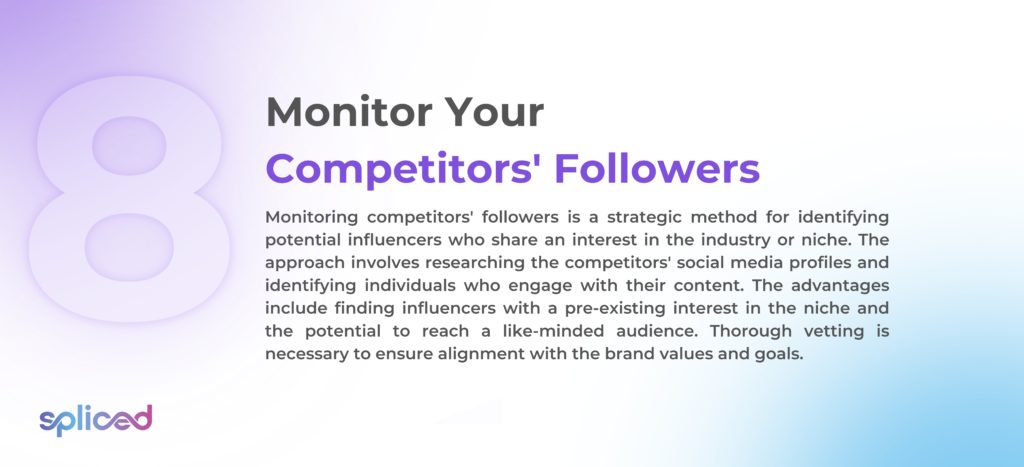
8. Monitor Your Competitors’ Followers
Monitor your competitors’ followers. Monitoring competitors’ followers is a strategic method for identifying potential influencers who share an interest in the industry or niche. The approach involves researching the competitors’ social media profiles and identifying individuals who engage with their content. The advantages include finding influencers with a pre-existing interest in the niche and the potential to reach a like-minded audience. Thorough vetting is necessary to ensure alignment with the brand values and goals. For example, identify fitness enthusiasts among the competitors’ followers who serve as influencers to promote the products to a fitness-focused audience if an individual has a fitness apparel brand.

What is an Influencer?
An influencer is an individual who possesses the ability to significantly impact the opinions, behaviors, or purchasing decisions of a specific audience, often through their authority, expertise, authenticity, or reach within a particular niche or industry. Influencers are characterized by their authority and deep knowledge of a specific subject, lending credibility to their recommendations beyond mere popularity. Influencers are known for their authenticity, establishing trust with their audience by sharing personal experiences and transparent content.
Influencers are set apart is their engaged following, where their followers actively participate in discussions, share their content, and seek their guidance. Influential people are associated with a niche or industry, allowing brands to target their marketing effectively. Influential people excel in content creation, crafting materials that capture attention and foster engagement. Influencers have a tangible impact on their audience, driving actions such as purchasing decisions or trend adoption, extending their reach beyond their immediate followers. Brands collaborate with an influencer, leveraging their influence in marketing campaigns, making them pivotal in connecting brands with their target consumers in a relatable and trusted manner.
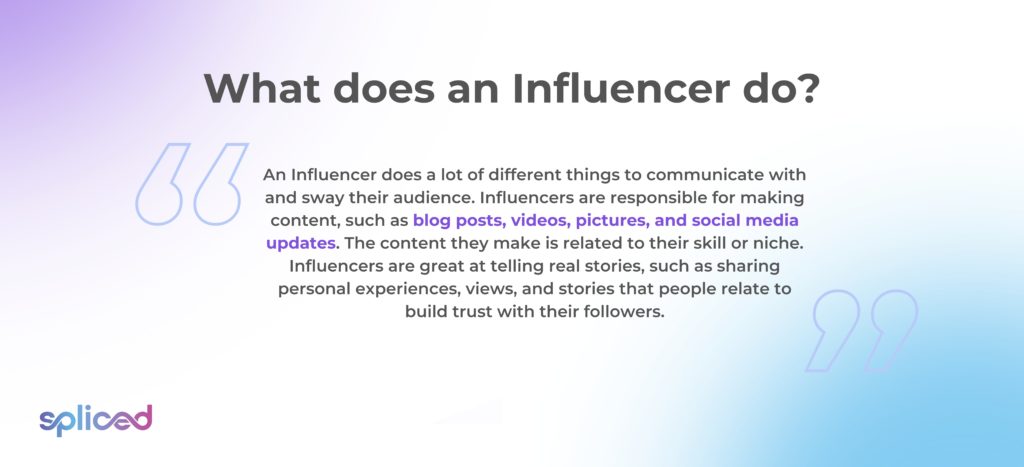
What does an Influencer do?
An Influencer does a lot of different things to communicate with and sway their audience. Influencers are responsible for making content, such as blog posts, videos, pictures, and social media updates. The content they make is related to their skill or niche. Influencers are great at telling real stories, such as sharing personal experiences, views, and stories that people relate to build trust with their followers. Influencers build and grow a community around their content by responding to comments, messages, and conversations with their audience.
An important part of what influencers do is work with brands. Influencers give honest suggestions, reviews, and endorsements, and they use goods or services naturally in their content to show how useful they are in their daily lives. Influencers set new styles, ideas, and trends, which encourages their fans to follow suit. Other influencers use their platform to speak out for causes they care deeply about, while others focus on educational material such as tutorials and guides.
Influencers are asked to host or take part in events, online and off. For example, they are asked to lead webinars, talk at conferences, or go to product launches. One more part of their job is making money. Influencers make money through paid posts, ad marketing, working with brands, and collaborating on products. An influencer give brands useful feedback and consumer insights by sharing their thoughts and views based on their own experiences and the experiences of the people who follow them. Influencers use their online presence, honesty, and knowledge to build, engage, inspire, and sway their audience. An influencer works with brands to promote goods or ideas their followers are interested in.
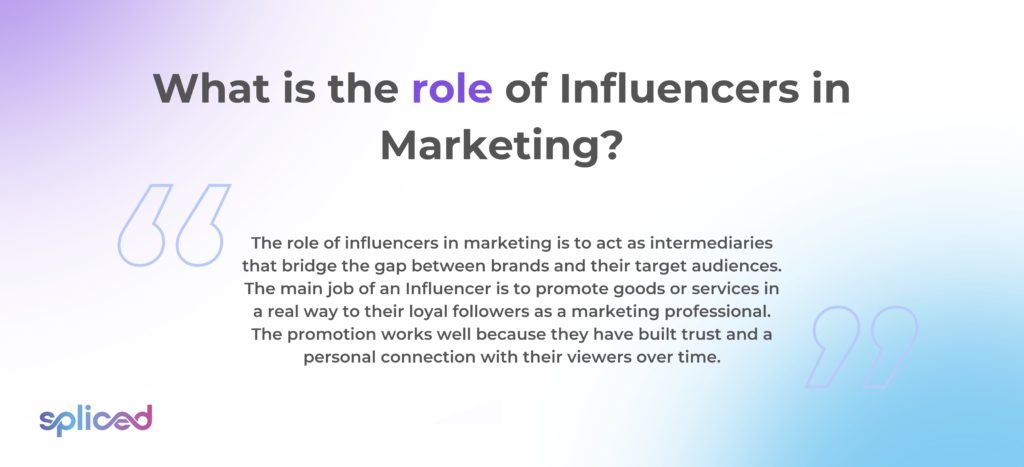
What is the role of Influencers in Marketing?
The role of influencers in marketing is to act as intermediaries that bridge the gap between brands and their target audiences. The main job of an Influencer is to promote goods or services in a real way to their loyal followers as a marketing professional. The promotion works well because they have built trust and a personal connection with their viewers over time. Influencers help a brand reach more people by letting them connect with their large followers, which connects them with customers that traditional advertising misses.
Influencers are skilled at making content that is interesting and familiar. An Influencer makes content that fits a brand’s message or product better into their niche, which makes it more appealing to their followers. Influencers build and keep trust, which makes their suggestions more powerful than standard marketing. An Influencer offers targeted marketing because they usually focus on certain niches or demographics. Targeted marketing makes marketing campaigns more precise and effective.
Influencer marketing is a strategy that uses the fame, authority, and reach of influential people to get a message, product, or service in front of a specific group of people. Brands work with influencers to make content, endorsements, or partnerships that reach the followers of the influencer as part of the marketing plan. The ultimate goal is to get people to know about, interact with, and buy from the company. Influencers in marketing work well because they use the influencer’s power to connect with their audience and get people to take action. Influencer makes it an important and trusted part of modern marketing efforts.
Experts are important when it comes to influencer marketing. Influencers give marketing efforts more credibility and trust because they already have a relationship with their public. Influencers are more followed than regular ads because their suggestions are based on facts. An Influencer frequently has very specific and niche-focused followings that help brands effectively reach their ideal customer groups. An Influencer has a special talent for making content that is interesting and relevant to a brand’s message when it comes to making content.
Influencers help brands reach new areas or demographics because they have a large following. Influencers are important because they add authenticity to marketing efforts by really liking a product or service. The sense of sincerity makes what they are promoting seem more valuable. Influencer marketing gives brands concrete results, so they see how well their campaigns are doing and make any changes that are needed.
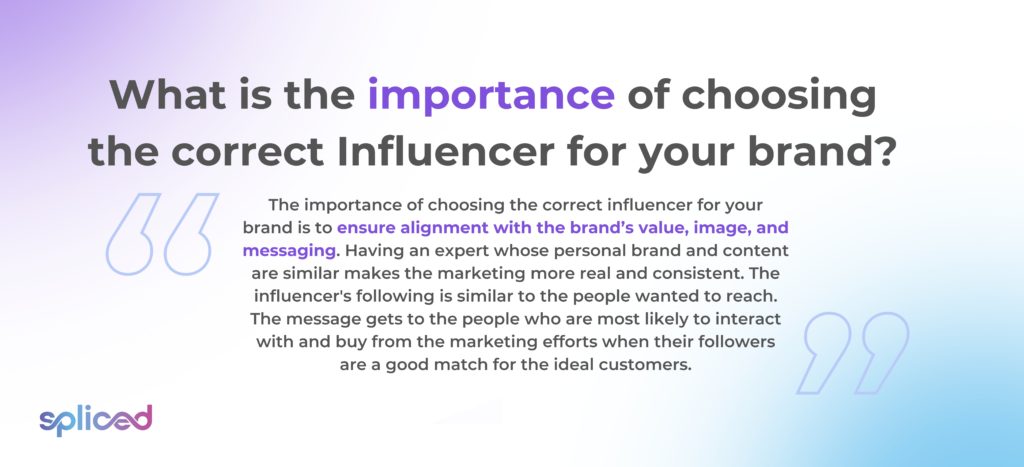
What is the importance of choosing the correct Influencer for your brand?
The importance of choosing the correct influencer for your brand is to ensure alignment with the brand’s value, image, and messaging. Having an expert whose personal brand and content are similar makes the marketing more real and consistent. The influencer’s following is similar to the people wanted to reach. The message gets to the people who are most likely to interact with and buy from the marketing efforts when their followers are a good match for the ideal customers.
Influencers are reliable information sources for the people who follow them. Linking the brand to a trustworthy influencer increases trust and credibility, making people more confident in the goods or services. Think about things such as the quality of the content, the style, the amount of engagement, the reach, and the budget when picking influencers.
Influencers are very important for improving a brand’s marketing. An influencer gives the message credibility and trustworthiness because their real support and excitement really connect with their audience. The realness makes people trust and believe in the brand. Influencers usually have clear-cut, niche-specific groups that brands directly reach. Niche-specific groups make marketing more effective and targeted. Influencers are great at making content that people want to read and relate.
The content gives the marketing efforts new life. Brands connect with customers that they do not reach through traditional advertising because they have a huge audience and a lot of active users. Influencers give useful feedback and customer insights based on their own experiences and the experiences of the people who follow them. It helps make product improvements and marketing plans.
Setting clear marketing goals and aims is an important step in finding the right influencers for the brand. Figuring out who want to reach is important because it helps to connect the brand with leaders whose followers are similar to the brand. Do a lot of research, such as looking through social media sites, databases of influencers, and publications that are specific to the business to find influencers for the brand.
The question “How to find the right influencers for the brand?” involves checking the style, quality, and tone of their writing to make sure that it fits with the look and message of the brand. Looking at engagement metrics such as comments, likes, and shares shows how well they connect with their community. Make sure they are real by checking their trustworthiness and legitimacy. Finding the right influencers for the brand’s influencer marketing campaigns are finished when reach out to influencers and negotiate terms, such as payment, content creation, and campaign expectations.
What will happen if the brand chooses the wrong Influencer?
A negative impact on the brand and its marketing efforts will happen if the brand chooses the wrong influencer. Choosing the wrong influencer leads to fake marketing efforts because the influencer is not really a fan of the brand or is fake in their endorsements. Wrong influencers hurt the brand’s image by making the influencer’s followers not trust and believe in them. An audience that is not a good fit means less engagement, reach, and sales, since the influencer’s followers are not in the same age group or share the same hobbies.
Brand image differences happen when the influencer’s content style, values, or message does not match up with the brand. Not matching up with the brand makes the audience confused and weakens the brand’s identity. Working with the wrong influencer wastes time, effort, and money, and marketing efforts do not get the results and return on investment (ROI) that is expected.
Another risk is bad press, which happens when the wrong influencer’s actions or behaviors are questioned. Bad press hurts the brand’s image and requires work to fix the problem. Picking the wrong influencer means missing chances to connect with the right people and make the marketing efforts more effective. Do a lot of research, set clear goals, and figure out the target audience to effectively find influencers for the brand. Check the influencer to see if the influencers are real and in line with the brand’s values. Researching helps reduce these risks and ensures a successful relationship.
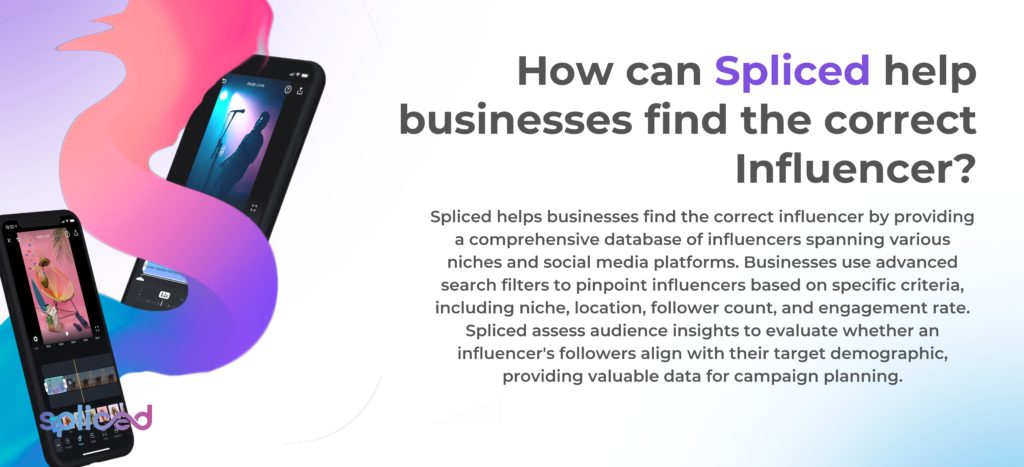
How can Spliced help businesses find the correct Influencer?
Spliced helps businesses find the correct influencer by providing a comprehensive database of influencers spanning various niches and social media platforms. Businesses use advanced search filters to pinpoint influencers based on specific criteria, including niche, location, follower count, and engagement rate. Spliced assess audience insights to evaluate whether an influencer’s followers align with their target demographic, providing valuable data for campaign planning.
Influencer platforms enable businesses to assess an influencer’s effectiveness by providing engagement metrics, including likes, comments, shares, and engagement rates. It goes beyond mere follower counts and provides a more accurate picture of an influencer’s impact. Businesses review an influencer’s past content to gauge its quality and alignment with their brand.
These platforms facilitate communication between businesses and influencers, simplifying the negotiation of terms and expectations for collaborations once an influencer is selected. They provide budget estimations to help businesses plan their campaigns effectively. Influencer marketing platforms offer tools for tracking performance, including metrics such as clicks, conversions, and return on investment (ROI) after a campaign is launched.
The effectiveness of using influencer marketing platforms like Spliced depends on several factors, including the platform’s database quality, the accuracy of audience insights, and the relevance of influencers to a business’s goals and target audience. Success in influencer marketing relies on strategic planning, creative collaboration, and effective execution, regardless of the platform used. Businesses must carefully evaluate and choose an influencer marketing platform that aligns with their unique needs and objectives to maximize the benefits of influencer partnerships.
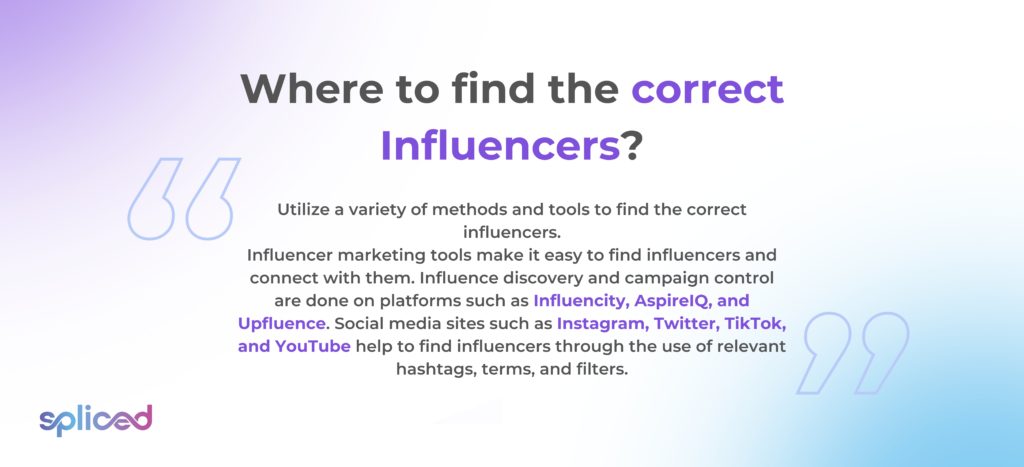
Where to find the correct Influencers?
Utilize a variety of methods and tools to find the correct influencers. Influencer marketing tools make it easy to find influencers and connect with them. Influence discovery and campaign control are done on platforms such as Influencity, AspireIQ, and Upfluence. Social media sites such as Instagram, Twitter, TikTok, and YouTube help to find influencers through the use of relevant hashtags, terms, and filters. Use industry-related keywords followed by “influencers” or “bloggers” in a Google search to find appropriate influencers.
Use social media listening tools such as Brandwatch, influencer sites including Social Blade and Grin, and agency services to help find the right influencers. Referrals from people in the same business or networking are helpful in finding influencers. Look through content platforms such as YouTube, Medium, and LinkedIn to find thought leaders and content creators in the field. There are apps and sites that help to find the correct influencers, but do a lot of research and evaluation to make sure they fit with the brand’s values and goals.
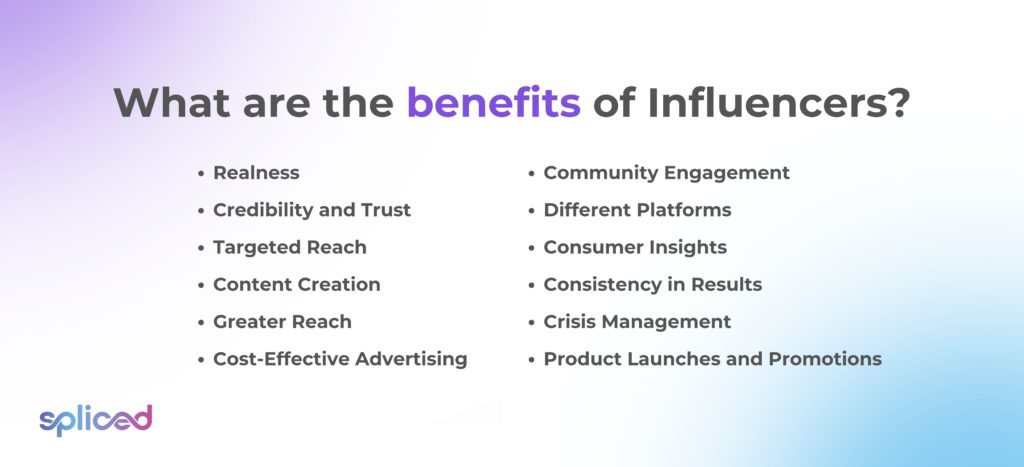
What are the benefits of Influencers?
The benefits of Influencers are listed below.
- Realness: Influencers are known for being real and easy to relate to, which makes their followers believe that the things they say and suggest are more real and trustworthy.
- Credibility and Trust: Influencers have earned the faith and trust of their followers over time. Influencer references are powerful because the people who follow them trust them as good sources of information and advice.
- Targeted Reach: Influencers have clear, niche groups that are very similar to the people a brand wants to reach. The specific reach makes sure that marketing efforts reach the right people.
- Content Creation: Influencers are skilled at making content that is interesting and approachable, which helps a brand’s marketing campaigns.
- Greater Reach: Many influencers have substantial followings, in terms of numbers and engagement levels. Brands connect with more people, which helps them reach new areas or demographics when brands work with influencers.
- Cost-Effective Advertising: Influencer marketing saves money compared to other types of advertising. Brands get a better return on investment (ROI) when brands work with influencers.
- Community Engagement: Influencers interact with the people who follow them, creating a sense of community around their material. The interaction makes people more loyal to a brand and gets them to connect with it more.
- Different Platforms: Influencers use a lot of different platforms, such as blogs, social media, YouTube, and more. Brands pick the ones that best fit their business goals because there are many options.
- Consumer Insights: Influencers give useful comments and ideas based on their own experiences and the experiences of the people who follow them. The feedback helps make products better and marketing plans more effective.
- Consistency in Results: Results from influencer marketing are measured, which lets brands see how well their campaigns are doing and make changes as needed.
- Crisis Management: Influencers are helpful when there is a problem with a brand’s image. They use their credibility and power to help the brand deal with bad press or misunderstandings.
- Product Launches and Promotions: Influencers are great for promoting and launching new products because they get their fans excited and interested.

What are the downsides of Influencers?
The downsides of Influencers are listed below.
- Lack of Authenticity: Not all influencers really believe in the goods or services they promote. Some people give fake endorsements, which hurt their reputation and trust.
- Oversaturation: There are many influencers in some areas and industries, which makes it hard to stand out or find influencers who really fit with the brand.
- Follower Fraud: There is a problem with fake followers and engagement in the influencer area. Some influencers buy followers or engagement metrics to make it look like they have more impact than they really do.
- Lack of Control: Influencers give up some control over the messages and material they share when brands work with influencers. Trusting the influencer’s creative process is important because it leads to unexpected results.
- Costs: Working with well-known influencers is pricey, and does not always get a good return on the investment (ROI). Brands need to think carefully about whether the benefits are worth the cost.
- Alignment Problems: Influencers want a good fit for a brand, but their actions, messages, or ideals do not match up with the brand’s. It harms the brand’s image.
- Concerns about Transparency: Paid partnerships or sponsored material being disclosed that is not clear, causes legal and moral problems for brands and influencers.
- Temporary Influence: The fame and importance of an influencer only last for a short time. People who are popular now are not as important in the future because trends change.
- Associations with Negative Events: Influencers become associated with negative events, scandals, or controversies in rare cases. Associations negatively impact a brand if they are tied to that influencer.
- Time-Consuming Vetting: Finding the right influencers for the brand is time-consuming, and needs to be carefully checked out to make sure they are real and match the brand.
- Concerns about sustainability: Customers care about things in an ethical and sustainable way. Brands need to make sure that the influencers they work with share these ideals.
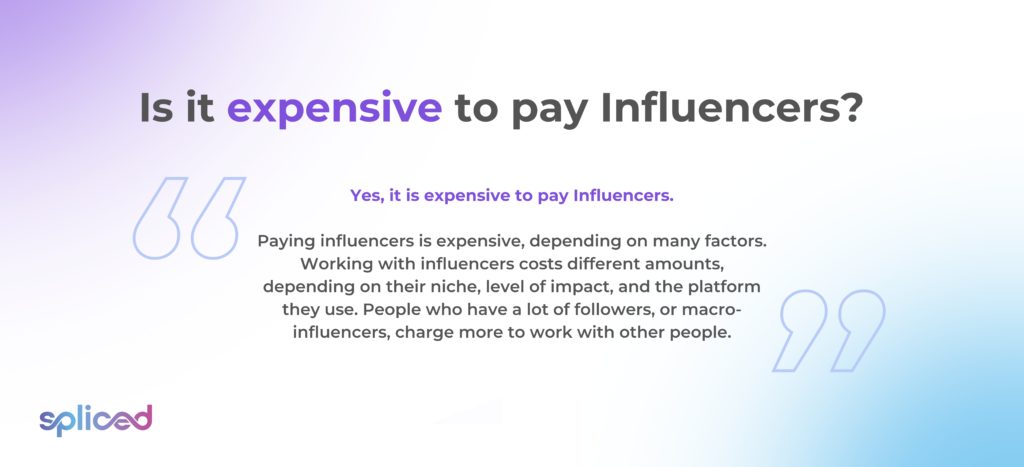
Is it expensive to pay Influencers?
Yes, it is expensive to pay Influencers. Paying influencers is expensive, depending on many factors. Working with influencers costs different amounts, depending on their niche, level of impact, and the platform they use. People who have a lot of followers, or macro-influencers, charge more to work with other people. The size of the campaign, the number of deliverables, and the fact that the partnership is private change the prices. Brands need to set aside money for influencer fees, especially if they want to work with well-known influencers. Not all partnerships with influencers involve money. Some influencers take goods, services, or other forms of payment for their endorsements.
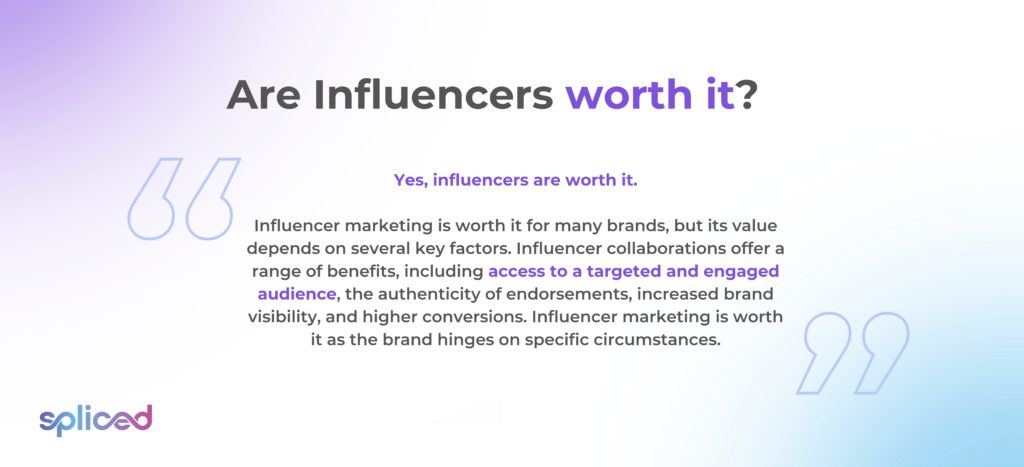
Are Influencers worth it?
Yes, influencers are worth it. Influencer marketing is worth it for many brands, but its value depends on several key factors. Influencer collaborations offer a range of benefits, including access to a targeted and engaged audience, the authenticity of endorsements, increased brand visibility, and higher conversions. Influencer marketing is worth it as the brand hinges on specific circumstances.
Start by clearly defining the marketing objectives and aim to achieve through influencer partnerships, whether it is brand awareness, engagement, or conversions to assess its value. Ensure that the influencers selected have an audience closely aligned with the target demographic, as the relevance of the influencer’s audience is paramount. Budget considerations are crucial, so evaluate whether the financial resources allow for influencer collaborations and how the investment aligns with the marketing strategy.
Prioritize authenticity by choosing influencers who genuinely resonate with the brand and are sincere in their endorsements, as authenticity is the cornerstone of building trust with their followers. Implement methods to measure the effectiveness of influencer campaigns, whether through tracking conversions, engagement metrics, or other key performance indicators (KPIs). Consider whether influencer marketing serves short-term goals, long-term brand-building efforts, or a combination. Influencer marketing is a highly effective component of the marketing strategy when executed strategically and aligned with the brand’s values.
What is the difference between Influencers and Celebrities?
The difference between Influencers and Celebrities is through their content creation and social media presence. Celebrities become well-known through traditional media, such as acting, singing, sports, or entertainment, where they reach the top of their fields. Another thing that sets them apart is how they interact with their audience. Influencers actively interact with their followers by responding to comments and starting conversations. Celebrities have large followings, but rarely interact with them because of their busy schedules and the one-to-many nature of traditional media.
A big part of what makes influencers great is that they are honest. Influencers connect with their audience by sharing personal experiences and views, which makes their suggestions and approvals real. Celebrities are real, but their fame is often linked to their roles or personas in the entertainment business, which makes it harder to tell if they are truly who they say they are.
Influencers focus on certain niches or industries, becoming known as experts or fans in areas when it comes to knowledge. They give specific information to a small group of people. Celebrities have a wider reach and fame that goes beyond specific niches. They have a fan base that is more diverse and spread out. Different influencers make money in different ways. Influencers make money through brand partnerships, sponsored posts, affiliate marketing, and selling goods. These are clear and straight ways to make money.
Celebrity makes money from many sources, such as endorsement deals, acting parts, music royalties, and public appearances. Agents and agencies handle all of these sources of income. Influencers have a lot of followers, but people only know them in the digital world. Celebrities are well-known in all kinds of media, such as TV, movies, music, and sports, making them well-known figures.
